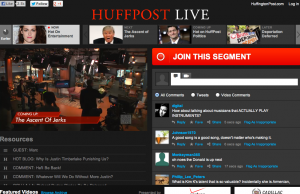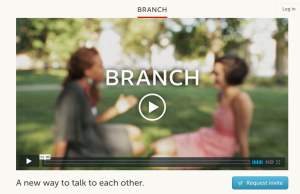Just when you thought that there could be no more new platforms for sharing and communicating with like-minded people, three new ones emerged this week. Whether these new platforms take off and gain Twitter or Pinterest-like traction remains to be seen, but they each seem to be worth at least checking out for potential future brand engagement opportunities.
Huffington Post Live
On Monday, the Huffington Post launch Huffington Post Live, a live news channel with social integration using Google+ Hangouts for viewer commentary. Huffington Post Live is a news “channel, ” but doesn’t feel as staid as traditional news programs. Instead, the hosts are young and relaxed, and the reporting is more conversational.
It is truly revolutionary in the way it builds in the video chat technology for live discussions. Traditional news outlets have been struggling to get the kind of viewer engagement that the Huffington Post just earned by turning on their online channel this week. This new channel takes advantage of the trend of viewers demanding more video content online (we’ve heard repeatedly that by 2015, video traffic will more than quadruple, and the Internet will be two-thirds made up of video). And advertisers are taking notice and want in on the ways to be a part of that video content that viewers are seeking:
“The channel will have 12 hours of programming on weekdays, and the effort reflects a serious push within the media industry to produce the kind of online video advertisers are requesting. Cadillac and Verizon are the two advertisers The Huffington Post calls “founding partners” of the network.” – New York Times
If Huffington Post Live can build an active audience with this cost efficient way of keeping content fresh all day, every day, advertisers will want to jump on board for the opportunity to engage with that audience in similar ways. It will be interesting to see if Huffington Post Live eventually offers segments for talking with brands/advertisers on the couch of their set.
Branch
Branch is a website that launched on Monday, as well. Its creators and funders included the founders of Twitter, Ev Williams and Biz Stone, so the site has some powerful thought-leaders behind it.
Branch is a platform that “entices people to start a longer, more in-depth conversation about a specific topic and invite others to join the discussion. Unlike most social networks, where anyone can join in and add their verbose opinions, only people involved in the conversation can invite others. This includes friends on Twitter and other social networks.” (New York Times) Basically, it is a controlled discussion forum for those times when you know who you want to talk to and hear from, like a dinner party conversation topic.
Though Branch is available for everyone use yet, you can request an invite on the site. I can see brands using this platform for focus group-like discussion for research purposes and really engaging loyal customers who are opinionated and want to participate in concept (product, service, creative) ideation.
Medium
Medium is also a site created and funded by the Twitter co-founders. It is more like a blogging platform that aggregates content.
“Medium looks like a mashup between more traditional blogging services and user-curated collections. Users can choose to read, give feedback or write their own material. All posts are organized into collections, and these collections share the same theme and template. Readers who like a post can give it positive feedback, increasing the likelihood that others will see the post.” – Mashable
According to the Medium website:
“Medium is designed to allow people to choose the level of contribution they prefer. We know that most people, most of the time, will simply read and view content, which is fine. If they choose, they can click to indicate whether they think something is good, giving feedback to the creator and increasing the likelihood others will see it.
“Posting on Medium (not yet open to everyone) is elegant and easy, and you can do so without the burden of becoming a blogger or worrying about developing an audience. All posts are organized into “collections,” which are defined by a theme and a template. (For example, this post is in the About Medium collection with a simple article template.)”
If Medium becomes a place like Tumblr where users aggregate their finds, thoughts and commentary, brands will likely jump on board to do the same and to be found by the audiences seeking information.
All three of these sites launched on Monday and are already the topic of many online conversations. Our communications world continues to rapidly iterate and the ways we share and consume information will only grow and expand. Brands and advertisers have to keep current with the opportunities and be ready to go where the people go.




